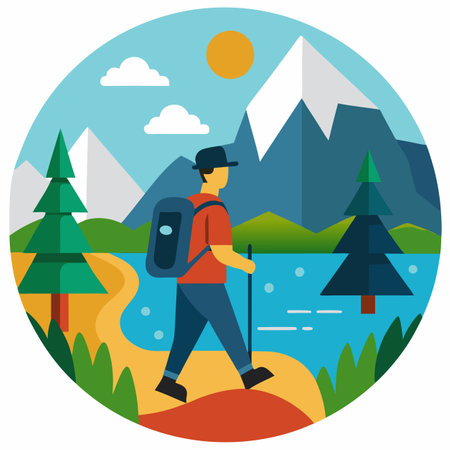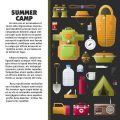Understanding the Backcountry
When it comes to survivalist camping in the United States, understanding what constitutes “backcountry” is essential for your safety and success. In American outdoor culture, backcountry refers to remote, undeveloped areas that are far from roads, amenities, and established campgrounds. Unlike popular campsites with designated fire pits, restrooms, and clear trails, backcountry terrain is rugged, wild, and often untouched by modern conveniences. Whether you’re exploring the vast forests of the Pacific Northwest, the dramatic peaks of the Rocky Mountains, or the expansive deserts of the Southwest, these environments pose unique challenges. Navigation can be tricky due to unmarked paths and unpredictable weather. Water sources may be scarce or require purification. Wildlife encounters are more likely, and medical help is often hours—or even days—away. Understanding these distinctions is crucial because venturing into the backcountry demands a higher level of preparation, awareness, and respect for nature’s unpredictability compared to camping in developed areas.
Essential Gear and Packing Tips
When venturing into the American backcountry for survivalist camping, your gear is your lifeline. The right equipment can mean the difference between a safe adventure and an emergency situation. Heres what you need to know about must-have survival gear, smart packing strategies, and lightweight options that are perfect for rugged U.S. wilderness environments.
Must-Have Survival Gear
| Category | Recommended Items | Why Its Essential |
|---|---|---|
| Shelter & Sleep | Lightweight tent or tarp, sleeping bag rated for local temps, sleeping pad | Protection from weather and wildlife; ensures rest and warmth |
| Navigation | Map, compass, GPS device (with spare batteries) | Avoid getting lost in vast wilderness areas |
| Water & Filtration | Collapsible water bottles, portable filter or purification tablets | Safe hydration from unpredictable water sources |
| Fire & Light | Waterproof matches/lighter, firestarter, headlamp with extra batteries | Warmth, cooking, signaling, nighttime safety |
| First Aid & Safety | Comprehensive first aid kit, whistle, personal locator beacon (PLB) | Preparedness for injuries or emergencies far from help |
| Food & Tools | High-calorie snacks, compact stove, multi-tool/knife, bear spray (in appropriate regions) | Sustenance and protection in wildlife-heavy areas like the Rockies or Appalachians |
Packing Strategies for Backcountry Safety
- Layer Your Pack: Place heavier items close to your spine and mid-back for balance. Keep essentials like snacks and first aid near the top or in exterior pockets for quick access.
- Pack for Versatility: Choose multipurpose gear—think a poncho that doubles as a shelter or a bandana usable as sun protection or a water filter.
- Mimic Real Scenarios: When prepping at home, lay out your gear as if you’re using it on the trail. This prevents overpacking and ensures everything has a purpose.
Lightweight Equipment Recommendations for American Wildernesses
- Tent: Consider ultralight models like single-wall tents or bivy sacks that withstand varied climates from the Sierras to the Smokies.
- Cookware: Titanium pots and sporks save weight without sacrificing durability.
- Packs: Go for frameless backpacks with modular features; many U.S.-based brands cater to thru-hikers and minimalist campers.
- Layers: Synthetic or merino wool clothing layers wick moisture and dry quickly—a must in humid East Coast forests or arid Western deserts.
The Bottom Line: Preparedness Meets Practicality
No matter where you roam—from the dense pines of the Pacific Northwest to the open mesas of Utah—your safety depends on careful planning. Stick to essentials, pack light but smart, and always tailor your gear choices to the specific challenges of Americas diverse wild places.

3. Navigation and Route Planning
When it comes to survivalist camping in the American backcountry, navigation is one of your most critical skills. The U.S. landscape offers vast wilderness areas—from dense forests in the Pacific Northwest to rugged mountains in Colorado and arid deserts in Arizona—each presenting unique challenges for campers. American navigation strategies emphasize a blend of traditional techniques and modern technology. First, mastering the art of reading topographic maps is essential; these maps provide vital information about elevation changes, water sources, and potential hazards like cliffs or marshes. Familiarize yourself with map symbols and contour lines before setting out.
Equally important is knowing how to use a compass. This classic tool never runs out of batteries or signal, making it invaluable when GPS devices fail due to dead zones or bad weather. Practice taking bearings and triangulating your position regularly to stay oriented. Additionally, many American adventurers now rely on GPS tools—whether standalone units or smartphone apps—to supplement their navigation. However, always download offline maps and mark key waypoints like campsites, trailheads, and escape routes before heading into areas with spotty cell service.
Local hazards should always influence your route planning. In some regions, you may need to avoid avalanche-prone slopes, flash flood zones, or areas with high wildfire risk. Before you go, check with local ranger stations or park services for updates on current conditions, closed trails, and recent wildlife activity. By combining traditional map-and-compass skills with modern GPS technology—and staying informed about local dangers—you’ll be well-equipped to navigate America’s wild places safely and confidently.
4. Wildlife Awareness and Encounters
Survivalist camping in the American backcountry means entering the habitats of a diverse array of wildlife, including bears, snakes, and mountain lions. Understanding how to safely coexist with these animals is critical for your safety and for preserving the natural environment. Here are practical tips to help you minimize risks and respectfully share the wilderness with its wild inhabitants.
Bear Safety Tips
- Store food properly: Always use bear-resistant containers or hang your food at least 10 feet off the ground and 4 feet from any tree trunk or branch.
- Cook away from camp: Prepare and eat meals at least 100 yards from your sleeping area to avoid attracting bears to your tent.
- Make noise: When hiking in dense brush or around blind corners, talk loudly or clap to alert bears of your presence.
Snake Safety Tips
- Watch where you step: Avoid tall grass, rock piles, and logs where snakes may be hiding. Always look before placing your hands or feet.
- Avoid night activity: Many venomous snakes are more active at night. Limit nighttime movement or use a flashlight to scan your path.
- If bitten: Remain calm, immobilize the affected limb, and seek medical help immediately. Do not attempt to suck out venom or apply a tourniquet.
Mountain Lion Precautions
- Travel in groups: Mountain lions are less likely to approach larger groups of people.
- Don’t run: If you encounter a mountain lion, maintain eye contact, stand tall, and slowly back away. Running can trigger their chase instinct.
- Defend yourself if attacked: Fight back using sticks, rocks, or whatever is available; do not play dead.
Quick Reference: Wildlife Encounter Guidelines
| Animal | Do | Dont |
|---|---|---|
| Bears | Back away slowly, speak calmly, make yourself look big | Run, leave food out, approach cubs |
| Snakes | Watch step, give space if encountered | Handle or disturb snakes |
| Mountain Lions | Maintain eye contact, make noise, appear large | Crouch down, turn your back, run away |
The Importance of Respectful Coexistence
Your actions can help protect both yourself and the wildlife that call America’s backcountry home. By staying alert and prepared, you contribute to a safer outdoor experience for everyone while ensuring these majestic creatures continue to thrive in their natural environments.
5. Weather Preparedness
Understanding and preparing for the ever-changing weather is a non-negotiable part of survivalist camping in the American backcountry. Knowing how to interpret local weather patterns is your first line of defense. Before heading out, check regional forecasts using reliable sources like the National Weather Service or trusted weather apps. Once in the wild, keep an eye on the sky—cloud shapes, wind direction, and temperature drops can all signal incoming changes. Sudden weather shifts are common in remote areas; always have your rain gear, extra layers, and emergency shelter easily accessible.
Preparing for Sudden Changes
The key to backcountry safety is anticipating the unexpected. Weather in mountain ranges or desert regions can shift from sunny skies to thunderstorms or temperature plunges within minutes. Pack for worst-case scenarios: thermal blankets, waterproof clothing, and fire-starting materials should be standard gear. Set up camp away from exposed ridges, tall trees, or dry creek beds to minimize risk from lightning strikes and flash floods.
Recognizing Region-Specific Dangers
Each American region brings its own set of weather hazards. In the West, wildfires are a real threat during hot, dry seasons—always check local fire restrictions and know multiple evacuation routes. In the Southwest or mountain valleys, flash floods can occur without warning after distant storms; never camp in low-lying washes or near riverbanks. Tornadoes are possible in some plains states, so understand local warning systems and safe shelter practices. Always respect nature’s power and err on the side of caution.
Stay Informed, Stay Safe
Carry a portable NOAA weather radio or satellite communicator if you’re far from cell service. Practice reading natural signs—such as sudden stillness or animal behavior changes—that might indicate shifting conditions. By staying vigilant and adaptable, you can navigate whatever Mother Nature throws your way while keeping your survivalist adventure both thrilling and safe.
6. First Aid and Emergency Response
Essential First Aid Practices for the Backcountry
When you’re survivalist camping in America’s backcountry, access to medical help can be hours—or even days—away. That’s why it’s vital to master basic first aid skills before heading into the wild. Start by packing a comprehensive first aid kit tailored for remote use: include bandages, antiseptics, blister treatments, tweezers, pain relievers, antihistamines, and any personal medications. Learn how to clean and dress wounds to prevent infection, manage sprains or fractures with makeshift splints, recognize and treat hypothermia or heatstroke, and perform CPR. Taking a wilderness first aid course is highly recommended for anyone planning to venture far from help.
Creating a Backcountry Emergency Plan
Having an emergency plan is as important as having the right gear. Before your trip, share your detailed itinerary—including route maps and expected check-in times—with a trusted friend or family member. Identify possible exit routes on your map and know the closest locations where you might find cell service or ranger stations. Assign roles within your group for managing emergencies, such as who will handle first aid and who will navigate if someone is injured. Practice emergency scenarios so everyone knows what to do if the unexpected happens.
Knowing When and How to Call for Rescue
In remote U.S. areas like the Rockies, Appalachians, or desert regions of the Southwest, communication can be tricky. Always carry a backup means of calling for help: a satellite phone, personal locator beacon (PLB), or GPS messenger device are invaluable when cell coverage is nonexistent. Know the signs of life-threatening injuries or illnesses that require immediate rescue—such as severe bleeding, head injuries, chest pain, inability to move, or altered consciousness. If you need to signal for help, use internationally recognized signals like three blasts on a whistle or three flashes of light. When contacting search and rescue teams, provide your exact location (coordinates if possible), describe the emergency clearly, and stay put unless moving is absolutely necessary for safety.
7. Leave No Trace Ethics
When it comes to survivalist camping in Americas wild backcountry, its easy to focus on personal safety and resourcefulness. However, its equally crucial to emphasize the importance of Leave No Trace (LNT) principles to ensure that these natural spaces remain pristine for future adventurers. Practicing LNT means going beyond simply picking up after yourself—it involves a mindset of stewardship and respect for the environment. This ethic is vital, especially in remote areas where human impact can linger for decades.
Pack It In, Pack It Out
One of the core tenets of Leave No Trace is packing out everything you bring with you. Whether its food wrappers, gear, or even biodegradable waste, nothing should be left behind. Survivalist campers often rely on minimal supplies, but every item counts. American landscapes are diverse and fragile; by removing all traces of your visit, you help preserve the integrity and beauty of these places.
Minimize Campfire Impact
Campfires are a traditional part of outdoor living, but they also pose risks—especially in drought-prone regions like California or Colorado. Use portable stoves when possible, and if fires are permitted, build them only in established fire rings. Always extinguish fires completely and scatter cold ashes away from water sources to prevent contamination and wildfires.
Respect Wildlife and Other Visitors
Survivalist camping sometimes necessitates close encounters with wildlife, but maintaining a respectful distance protects both you and the animals. Store food securely and never feed wild animals—it disrupts their natural behaviors and can endanger both parties. Additionally, keep noise levels down and be considerate of other explorers who seek solitude in Americas backcountry.
Leave What You Find
While it might be tempting to collect rocks, plants, or historical artifacts as mementos from your adventure, these actions can harm fragile ecosystems or erase cultural heritage. Take photos instead and leave nature as you found it so others can enjoy the same sense of discovery.
The Long-Term Impact
By embracing Leave No Trace ethics while practicing survivalist camping, youre not just safeguarding your own experience—you’re helping to ensure that Americas vast wilderness remains unspoiled for generations to come. Remember: true backcountry safety includes protecting the land itself.


